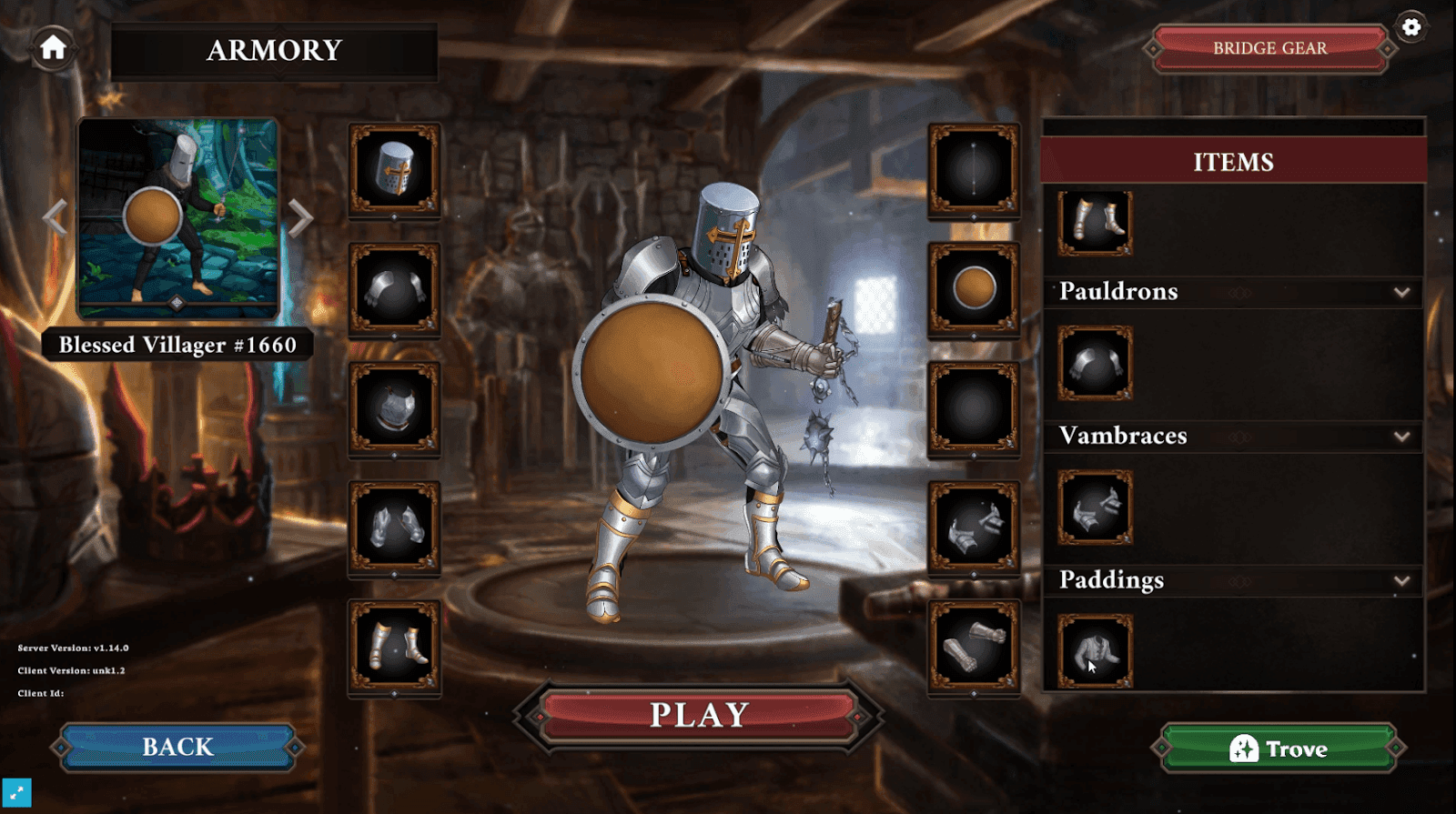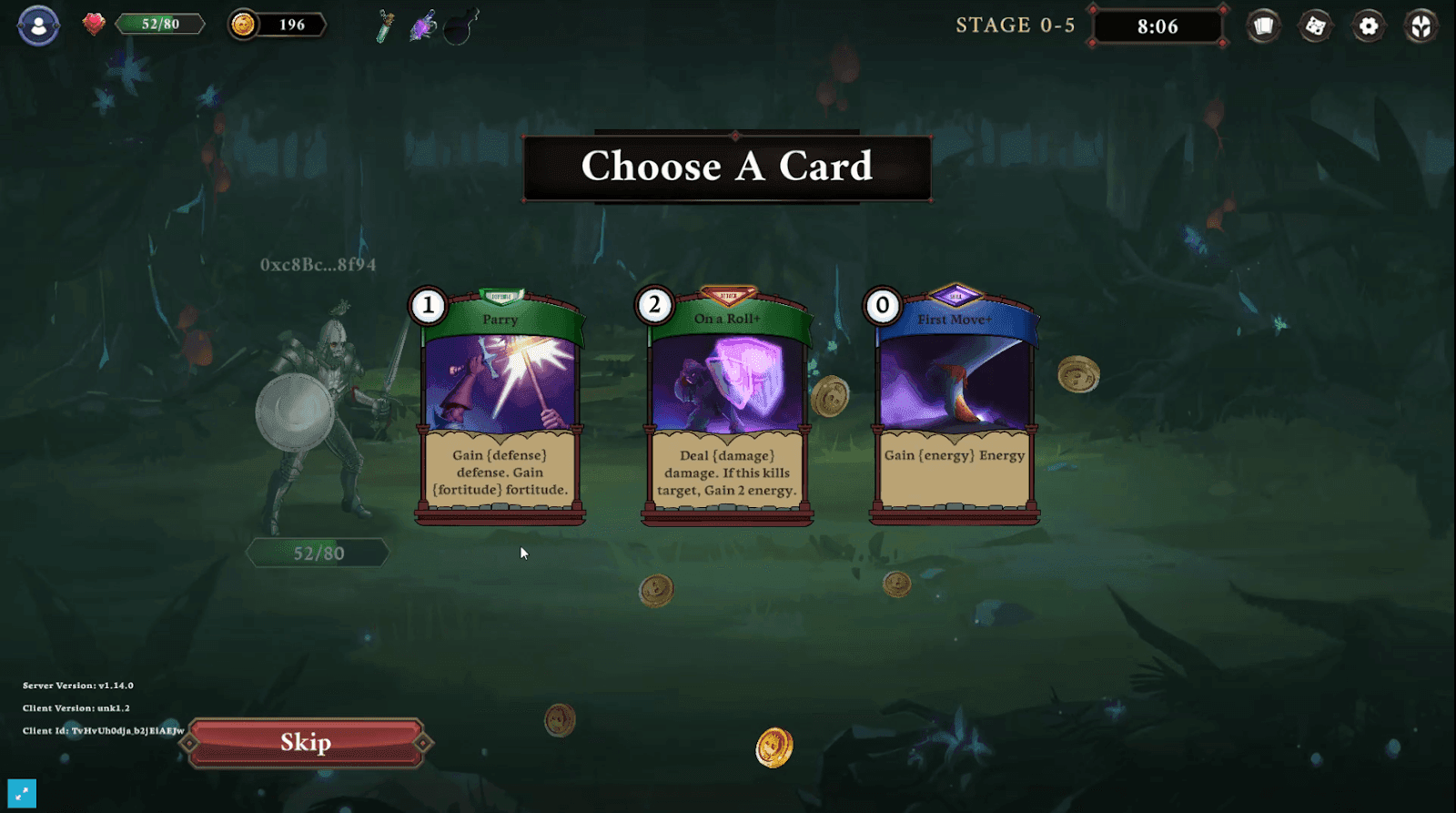Overview
Knights of the Ether (KOTE) is a game that requires strategic thinking, utilizing a deck-building mechanism to enhance the player's abilities while embarking on a campaign set in a randomly generated map.
In our Knights of the Ether guide, we provide insights into the available paths for each player and how to optimize them for obtaining valuable loot from the end-of-campaign boss.

Knights of the Ether Characters
There are three character choices in this game: Villager, Blessed Villager, and Knight.
- Villagers can be obtained for free through KOTE's website but are ineligible for loot at the end of the campaign and limited to one campaign per day.
- Blessed Villagers can be obtained through KOTE's website for $33 worth of Magic tokens and allow players to acquire loot at the end of the campaign. If you aim to enhance your gaming experience or seek profitable gear to sell, this is the most cost-effective option.
- Knights can be purchased through Trove's marketplace under the KOTE collection and are currently the most expensive choice. However, they offer advantages such as the highest HP (80 health) and come fully equipped. Knights can run the campaign twice a day, while Genesis Knights can complete it three times daily.
Now let's discuss the Armory. As a Villager or Blessed Villager, the gear you obtain during gameplay can be equipped here to enhance your character. This includes buffs such as damage increase or damage reduction. The specific bonuses for each item are yet to be disclosed by the game, making it speculative to determine the benefits of different rarities. Nonetheless, the Armory serves an aesthetic purpose, allowing you to customize your character's appearance.

Knights of the Ether Gameplay
At this point, you are on the doorsteps of Knights of the Ether’s gameplay. Upon clicking "Play" in the Armory, you will be presented with a map featuring four different starting options. Each route on the map offers various checkpoints, ranging from Treasures to Spirit Wells.

Swords marked with blood indicate elite combat, which entails facing more challenging monsters. This option is recommended for players with a solid understanding of the game, especially those playing as a Blessed Villager or Knight. Normal combat areas vary in difficulty, with the lowest difficulty located at the bottom and increasing as you move upward. If you aim to acquire powerful cards early on, completing the highest difficulty combat possible is ideal, as it offers greater card rewards.
Treasure points on the map provide a variety of rewards, including gold and cosmetic items. Gold becomes valuable when encountering a merchant, as it can be traded for card upgrades and potions. Maintaining a healthy balance of gold proves advantageous, enabling you to upgrade multiple cards and acquire health potions, ultimately making your journey easier.

The other checkpoint you encounter on the map is the Spirit Well. Typically, you'll come across a Spirit Well checkpoint two to three times during each campaign. These checkpoints offer you the choice of resting to restore your health or upgrading your cards to increase their power. If your health is low and you have numerous combat encounters ahead, resting would be a wise decision. However, if you're fortunate enough to have a high health level, it's more advantageous to use these checkpoints for card upgrades.

Knights of the Ether Combat
Now, let's delve into combat. Knights of the Ether (KOTE) is a deck-building game, where players utilize a set of cards. Each turn, the player receives five cards from their deck and has three energy points to maximize their card usage.
The cards in KOTE can be categorized into three main types: Attack, Defense, and Buffs. Generally, each card requires one energy point to play, allowing the player to use three cards per turn. Once the player finishes their turn, the cards go into the used pile and are reshuffled into the usable pile only when the player runs out of cards.
Let's take a closer look at the Attack cards. The primary card in this category is the basic attack card, which deals five damage to enemies. However, this effect can be countered if the enemy possesses a defense bonus, indicated by a shield icon next to their health bar.
Other types of attack cards include Burn and Torch, which apply a burn effect to the enemy. Burn causes the character to damage the enemy at the end of their turn, while Torch doubles the burn effect. It's beneficial to stack burn effects on the enemy before using Torch to unleash a significant amount of damage.

Next, we have the Defend cards, which grant up to 5 defense points to the character. This negates damage from the enemy up to the amount of defense currently on the character. Some cards in this category allow you to trade energy points for defense.
For example, if you have two energies remaining, you can gain 18 defense points, as each energy point translates to 9 defense points. These types of cards are obtained from more challenging combat encounters later in the campaign. They can prove particularly useful if you strategically stack their effects.

As shown in the image above, the character possesses five defense points, negating five damage from the enemy. Additionally, the enemy has ten burn points, meaning that ten damage will be inflicted at the end of their turn.
Finally, we have the last category of cards, which provide buffs and multiplier effects. These cards offer various benefits, such as gaining fortitude and defense for further damage reduction or granting energy points without consuming any energy themselves. These cards are not part of the starting deck and must be earned through combat while progressing through the campaign.
Knights of the Ether Tips and Tricks
It's recommended to save these cards for higher difficulty battles, as they can significantly ease those encounters. As depicted in the image below, utilizing the energy-granting card in combination with the middle card allows the player to effectively take multiple turns within a single turn, enabling them to gain an advantage in battle.

Now that you have a grasp of the card effects and combat mechanics, it's time to consider the strategy you'll adopt to reach the final boss. Defeating the end boss is the ultimate goal of the game, as it determines whether or not you obtain loot. If you haven't been fortunate with the treasure checkpoints, it can feel like time wasted.
Developing a strategy to preserve your health early in the game can prove advantageous, depending on the placement of Spirit Wells. These Wells change location with each randomly generated map, which refreshes every 24 hours. If a Spirit Well is situated near a combat area and you feel confident with your cards early on, it may be wise to engage in elite combat encounters. This will reward you with more powerful cards to utilize later in the campaign.
However, if you have a character with lower health, such as a Blessed Villager rather than a Knight, and you don't feel prepared for early elite combat due to the Spirit Well being a few locations away, it's advisable to choose a normal combat site and progress steadily through the map. We recommend attempting higher difficulty combat encounters at some point in the journey, as this increases your chances of obtaining higher rarity loot that you can either equip or sell.
We hope you found this Knights of the Ether guide enjoyable and informative. Have a great time playing through the campaign, and may you achieve glorious victories and revel in the spoils of excellent loot!
Share this article and tag us on any of our socials to let us know.

